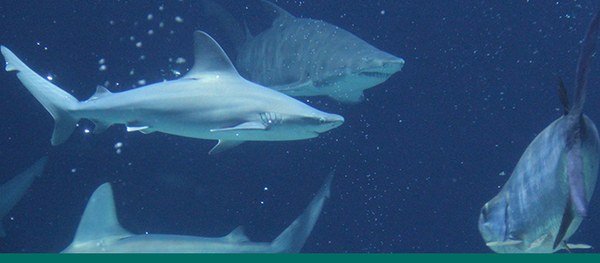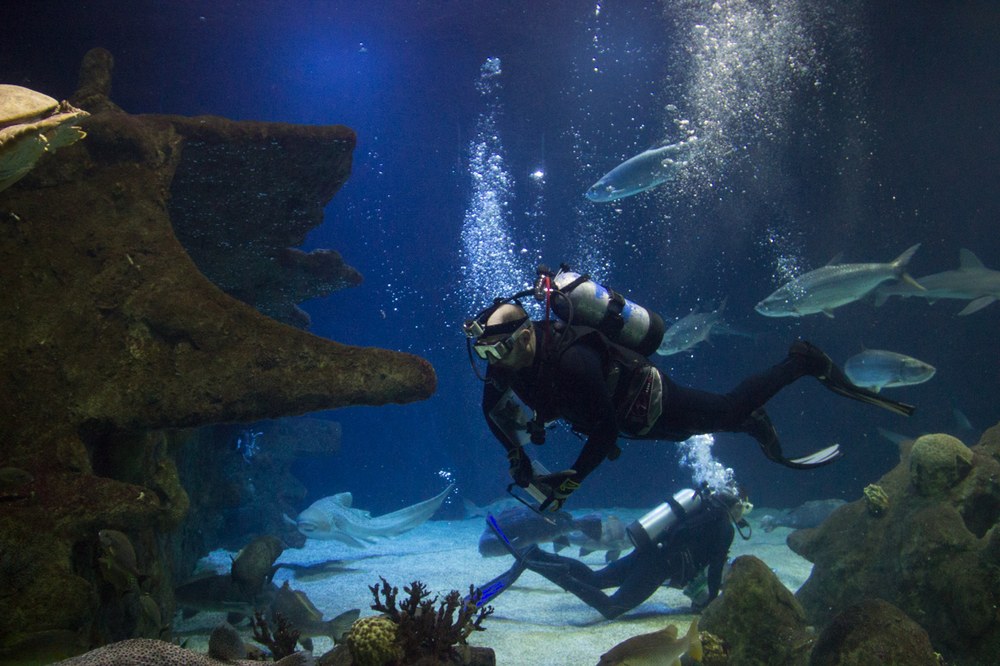Sharks
Learn more about the ocean's super predators.

Not so vicious
Sharks have an unfortunate reputation as vicious predators, but more than 20 of these large fish co-exist peacefully together (and with hundreds of other animals like smaller fish, turtles and sting rays) in the ABQ BioPark Aquarium Shark Tank.
The tank’s shark inhabitants include sand tigers, sandbar sharks, a tasseled wobbegong, blacktip sharks, nurse sharks and zebra sharks.
One might imagine that so many sharks in a close proximity might either quarrel or bond together, but these sharks behave more like their wild counterparts by simply coexisting peacefully.
And these vicious predators aren’t so vicious—divers swim alongside them every day during their Shark Tank dives at 2 p.m.
Divers feed the sharks once a week using a pole with prongs on the end. They feed each shark individually, making sure not to allow two sharks to pursue the same fish. Although some of the sharks try to get more than their fair share, the tank is calm during feedings—they seem to know they'll each get their turn. Learn more about the Shark Tank divers and feeding time here.
One diver noted that the sharks are very perceptive and one of the sandbar sharks has even displayed keen observation skills by looking divers directly in their eye.
While black tip sharks are aggressive hunters, they are perhaps the shyest of the shark species in the tank, alongside the larger, slow-swimming sand tigers, who like to keep their distance from divers.

Super Predators
Powerful, streamlined bodies and the unique ability to detect electrical fields from living prey make sharks extraordinarily efficient hunters. Of the more than 350 known species of sharks, most prey on other fishes, invertebrates or marine mammals.
Sharks can find prey buried under sand! They have small pores on head and snout that sense minute electrical fields from other fishes, even when they’re buried in the sand.
Although it looks smooth, shark skin is rough, like sandpaper. Sharks don’t have scales like other fishes. Their skin is covered with thousands of tooth-like plates called denticles that protect them like armor.
Not all species of shark must move to survive. Bottom feeders like nurse sharks can rest on the sea floor for long periods of time, but species that hunt in the open ocean may need to swim constantly to keep water flowing through their gills.
Sharks come in all sizes, from dwarf sharks at only 6 inches to whale sharks that are 50 feet long and weigh more than 20 tons—or 40,000 pounds.
Will Sharks Survive?
For 400 million years, sharks have cruised Earth’s oceans, their dominance uncontested. Now many shark populations, including great whites, are in trouble. Overfishing, trophy hunting, slow maturation and naturally low rates of reproduction have reduced their numbers alarmingly during the past century.
Shark fishermen still land thousands each year, but the catch is dwindling rapidly. The soupfin shark fishery provides an example of why some species are disappearing. When sharks are caught, their fins are sliced off and their bodies dumped back into the ocean as waste. Unable to swim, they're either eaten, drown or die of starvation.
